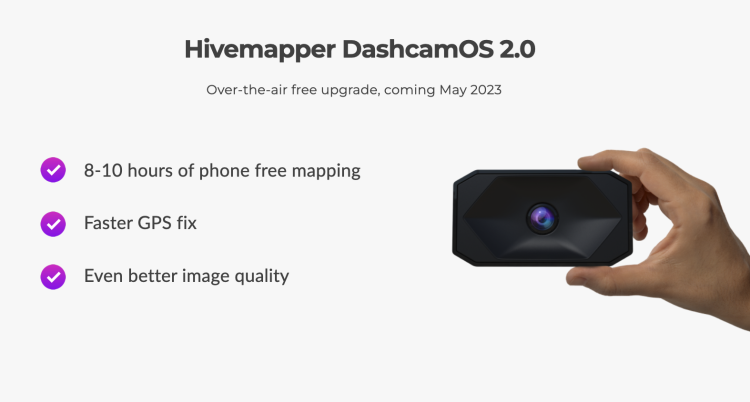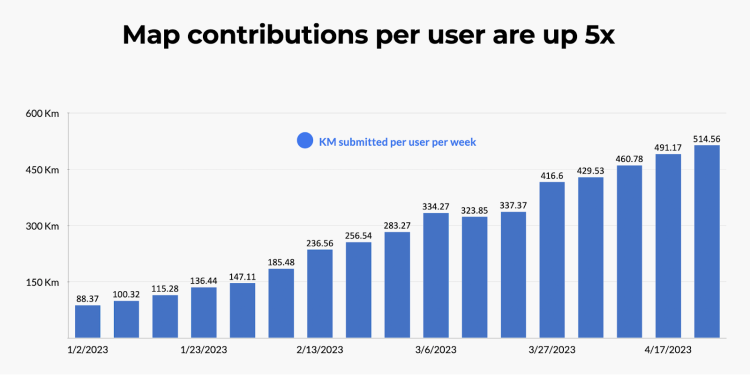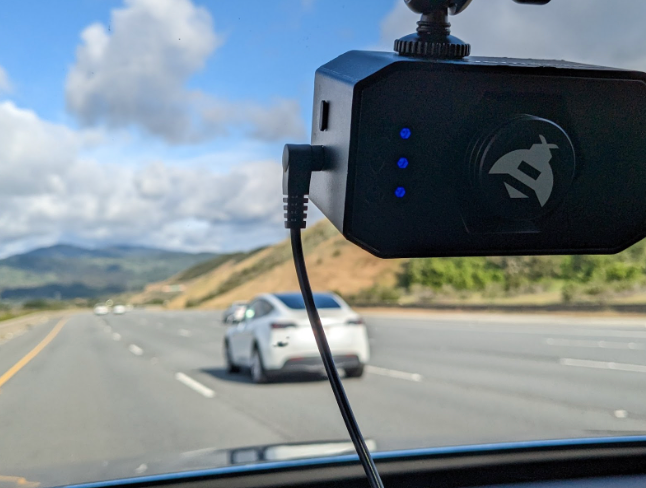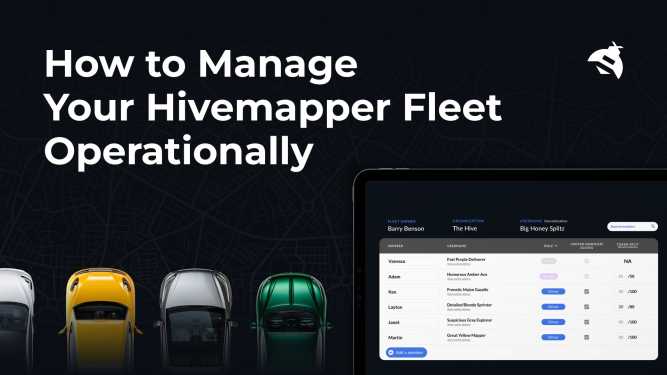The Latest Buzz
Mapping Just Got Way Easier: Introducing DashcamOS 2.0

We love over-the-air updates.
Upgrading hardware is expensive, slow and logistically difficult. Updating software is almost instant. If you take advantage of this, you can design a product that gets better and better over time, instead of getting worse and worse from the day you take it out of the box.
A year-old Tesla has more features than when you bought it. A year-old iPhone can download all kinds of apps that didn’t exist a year earlier. And when DashcamOS 2.0 is released later this month, a six-month-old Hivemapper Dashcam will immediately become dramatically better at helping contributors collect map data and mine HONEY rewards.
You might be wondering why DashcamOS 2.0 is such a big deal, compared to the dozens of firmware updates that we’ve released over the past few months. The answer: this is a giant leap toward making mapping truly effortless.
It includes an estimated 8 to 10 hours of mapping without pairing your phone, as well as a significant improvement in the speed of achieving a GPS fix and starting Hivemapping.
Currently undergoing internal testing, DashcamOS 2.0 is on track to be released to a small group of contributors this week. If all goes well with testing, we expect to release DashcamOS 2.0 to all users as a firmware and app update towards the end of May.
You asked, we listened
Since the launch of the Hivemapper Dashcam and Hivemapper Network in November, thousands of contributors have mapped more than 10 million total kilometers and 2 million unique kilometers of roads.
Many of our devoted early adopters gave us the tough-but-fair feedback that mapping was not yet the effortless, set-it-and-forget-it experience that the next few million users would expect.
We reacted to this feedback with a steady series of firmware and app updates, and the impact is clear. At the beginning of the year, the average map contributor mapped the equivalent of 88.4 kilometers of roads per week. Today, this number is more than 5x higher at 514.6 km per week.
But these changes did not address many of the distinct pain points that would allow pro drivers (think rideshare, delivery, and commercial fleets) to fit Hivemapper into their daily routine.
- Rideshare drivers needed to keep the Uber or Lyft app open in the foreground for navigation, and would lose connection between the dashcam and the Hivemapper app
- Food delivery drivers needed to turn off their car when they parked outside a restaurant or home, resulting in minutes of waiting for the dashcam to restart and resume mapping
- Commercial fleet owners needed to spend time teaching employees with varying levels of motivation and tech savvy to keep the dashcam successfully mapping
Many of these pro drivers found clever workarounds, grabbing forgotten old phones to use them as mapping devices, and installing backup batteries that could keep the dashcam powered even with their car turned off. Ingenuity finds a way.
We designed DashcamOS 2.0 for them.
From a gig driver’s point of view
A classic example of a user who will benefit from DashcamOS 2.0 is @JavierRAMBO, who has a side hustle driving for Uber Eats in Phoenix, Ariz. to fund his crypto investments.
He says that speeding up GNSS lock and dashcam startup time will be particularly helpful for delivery drivers. Delivery drivers for Uber Eats and Doordash typically complete 2 to 4 deliveries per hour. This means turning off their car 4 to 8 times per hour and potentially losing 10 minutes or more of Hivemapping to dashcam startup time.
To avoid losing power to his dashcam, @JavierRAMBO often leaves his car running while he runs into a restaurant to grab a customer’s order - even though he knows he’s wasting fuel and opening up the risk of someone driving off with his car.
He’s also excited about being able to map without having his phone connected to the dashcam. Currently, when the connection between dashcam and phone is lost, the bottom light on the dashcam turns red. With the launch of DashcamOS 2.0, those lights will be illuminated in Hivemapper’s signature blue as long as the dashcam continues doing its thing.
“When the light turns red, it’s stressful,” @JavierRAMBO says. “Whether the dashcam is still collecting images or not, in my mind as an Uber Eats driver it feels like I am not getting images and I have to fix it. I think the new setup where the dashcam does everything on its own for 8 to 10 hours will be a game-changer because I won’t need to worry about reconnecting. The dashcam will just be sitting there, always collecting.”
Although they have fewer challenges today than food delivery drivers, DashcamOS could make a difference for rideshare drivers such as @Gezza, an avid surfer based in Newcastle, Australia who maps with an exterior-mounted dashcam attached to his surfboard rack on his roof.
@Gezza said that when he started Hivemapping a few months ago, using the Uber app in the foreground and moving the Hivemapper app to the background could cause him to lose connection to the dashcam. With more recent updates to the app, it works much better.
DashcamOS 2.0 could kill that anxiety for good, and @Gezza is also excited about spending less time waiting for the dashcam to start up and get a GNSS lock.
“If it can get to the point where you can get in the car, off you go and the dashcam just works, that would be perfect,” he says.
Simplifying mapping for commercial fleets
DashcamOS 2.0 is also expected to boost mapping and earnings for commercial fleet managers such as Frank Cheng, owner of Taiwan-based Hivemapper official distributor SONoC as well as a water distribution business in northern California.
H2O Water, based in Hayward, Calif., has six water delivery vehicles serving a total of 5,000 accounts across northern California. On any given day, each of those trucks leaves carrying 288 five-gallon bottles of water and makes about 50 stops to drop off and pick up bottles.
It’s a perfect fit for building a map; the routes are always different, covering varied ground across residential, commercial and industrial areas.
Cheng installed Hivemapper dashcams and company phones in his vehicles and trained his employees on how to use them. He is excited for DashcamOS 2.0 to make it effortless for them.
“Sometimes when the workers come back, there’s no photos on the phone. They say, ‘Ah, I’ll try again tomorrow,” Cheng says. ““I can’t wait until all I have to do is keep the dashcam plugged in and turn on the engine, and it’s earning.”
How it works
Of all the changes in DashcamOS 2.0, the most important and technically challenging was enabling the dashcam to store 8-10 hours worth of map data without being paired to a phone.
Hivemapper did this by moving what we call the “motion model” from the app to the dashcam, and by reallocating how the dashcam stores imagery.
The motion model matches images to location data and bundles this information together. Although the Hivemapper Dashcam collects imagery at 10 frames per second, the map doesn’t need all of that imagery. If you’re sitting at a red light for two or three minutes, uploading and processing thousands of images of the same intersection doesn’t add any value.
In the old paradigm, the Hivemapper app and dashcam were in constant communication to decide how to create bundles. This put a lot of stress on both systems. In the new paradigm, the responsibility for creating bundles moves entirely to the dashcam and the only job of the phone is to download the finished bundles of images and upload them to the Hivemapper cloud.
With the motion model running on the dashcam, DashcamOS 2.0 was also able to reallocate more storage towards bundles and less towards raw imagery. Previously the app needed a lot of raw imagery to pull together bundles, but the dashcam doesn’t need to hold onto as many raw images to do the same job. This makes more space for bundles and enables many hours of passive image collection before the dashcam needs to offload bundles to the phone to free up space for new ones. Of course, the storage reallocation does not impact contributors who want to store dashcam imagery on a USB-C drive for personal use.
For more details on DashcamOS 2.0, and to stay on top of the release plans, we encourage you to join the 7,000+ members of the Hivemapper server on Discord.
Share Post





